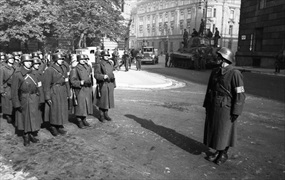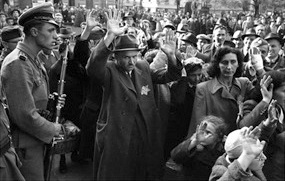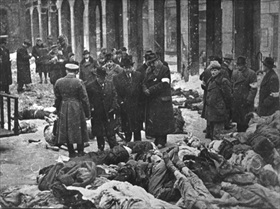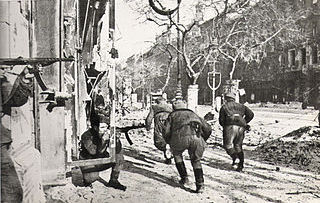BUDAPEST GARRISON NOW SOVIET CAPTIVES
Budapest, Hungary · February 14, 1945
On December 29, 1944, Soviet and Romanian troops (Romania was now a Soviet ally) began laying siege to Budapest, the capital of Adolf Hitler’s vassal state of Hungary. Budapest, split in two by the River Danube, was a city of over 800,000 resi¬dents and refugees, including well over 100,000 Jews living in Europe’s only surviving ghetto or in hiding.
On this date in 1945 Budapest’s 35,000-man German garrison entered Soviet captivity in a mini-replay of the German Sixth Army’s surrender at Stalingrad in late January–early February 1943. The industrial area of Pest on the left (east) bank of the Danube had been cleared of German troops in mid-January, but troops on the right (west) bank in Buda, supported by heavy artillery that commanded the heights over the city where the royal palace was located, held out until it was clear that relief efforts had failed. Heavy fighting and heavy artillery turned the palace into a heap of ruins.
The human cost of one of the fiercest battles of World War II was extreme: 80,000 Soviet troops perished, as well as 38,000 German and Hungarian defenders (out of the original 70,000) and 38,000 Hungarian civilians—25,000 civilians from starvation, disease, and other nonmilitary causes. No other European capital—apart from Warsaw and Berlin—suffered a similar fate, with soldiers on both sides engaging in tank and artillery duels and hand-to-hand combat one street, one building, and one cellar (where most residents lived) at a time. Tragically, German and Hungarian resistance to the Soviet advance permitted the native Arrow Cross fascists, in power since October 1944, to massacre some 15,000 of Budapest’s Jews who had managed to escape deportation to Nazi death camps.
In March 1945, with Hungary nearly rid of German troops (the last units retreated southward into Yugoslavia on April 4), half a million Soviet combat and support troops launched an offensive to take Vienna, capital of neighboring Austria to the west. On March 30 troops crossed the Austrian frontier and seven days later smashed their way into Vienna. By April 13 they had completed its capture, seven years short of one month after Hitler had forced Anschluss (union) on the country of his birth.
[amazon_carousel widget_type=”ASINList” width=”600″ height=”200″ title=”Recommended Reading” market_place=”US” shuffle_products=”False” show_border=”False” asin=”0752466313,1848859732,0415929695,2352501555,0814326919,1468160052,0815609809,0823233448,0271032448,190767764X” /]
Siege of Budapest, December 29, 1944, to February 14, 1945
 |  |
Left: Hungarian Arrow Cross Party militia stand at attention. In the background are German soldiers and a German tank, Budapest, mid-October 1944. The Germans helped the fascist Arrow Cross Party seize the reins of government after Miklós Horthy, Regent of the Kingdom of Hungary (1920–1944), announced Hungary’s withdrawal from the war.
![]()
Right: German and Hungarian soldiers drive Jews rounded up in Budapest into the City Theater, October 1944. During the short rule of the Arrow Cross Party (October 15, 1944, to March 28, 1945), between 10,000 and 15,000 people (many Jews among them) were murdered outright—thousands were shot on the banks of the Danube—and 80,000 people were deported from Hungary to their deaths in the Auschwitz concentration camp in Nazi-occupied Poland.
 |  |
Left: Jewish victims of Arrow Cross militia in the courtyard-cum-cemetery of the Dohány Street Synagogue, which bordered the Budapest Ghetto at its rear. The largest synagogue in Europe, “The Great Synagogue” (or “Tabakgasse Synagogue” by which it was also known) was used as a base for German radio broadcasts and as a stable during the war. Over 2,000 ghetto residents who died from hunger and cold during the harsh winter of 1944–1945 were buried here. A rear courtyard a short distance away holds the “Memorial of the Hungarian Jewish Martyrs”—at least 400,000 Hungarian Jews were murdered by the Nazis and their Hungarian collaborators. The memorial is a polished metal sculpture resembling a weeping willow whose leaves bear inscriptions with the names of victims.
![]()
Right: Street fighting in Budapest. A third of the nearly 80,000 German and Hungarian soldiers who fought the Soviet advance were killed and the rest ended up in Soviet captivity. After liberating the whole of Hungary in early April 1945, the Soviets brought members of the Arrow Cross government to trial and executed them.
Scenes from the Battle of Budapest 1944–45 Set to Music and Words
![]()
 History buffs, there is good news! The Daily Chronicles of World War II is now available as an ebook for $4.99 on Amazon.com. The ebook contains a year’s worth of dated entries from this website. Featuring inventive navigation aids, the ebook enables readers to instantly move forward or backward by month and date to different dated entries. Simple and elegant! Click here to purchase the ebook.
History buffs, there is good news! The Daily Chronicles of World War II is now available as an ebook for $4.99 on Amazon.com. The ebook contains a year’s worth of dated entries from this website. Featuring inventive navigation aids, the ebook enables readers to instantly move forward or backward by month and date to different dated entries. Simple and elegant! Click here to purchase the ebook.












